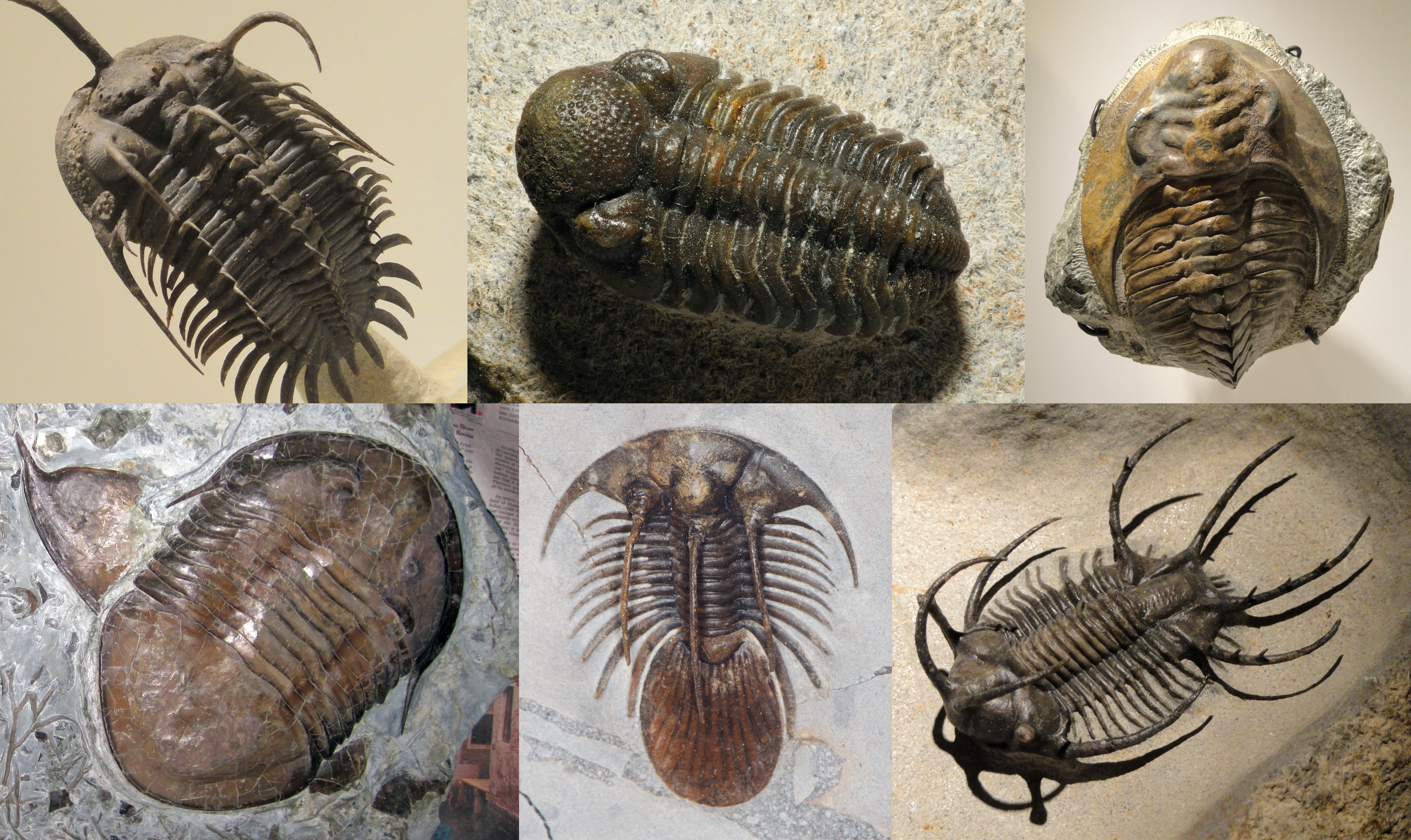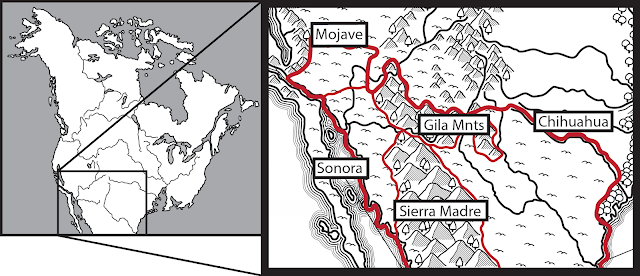Creatures of Taarsh - Part 1
The following is the first of three posts which provide the information and tools for referees to create creatures with which to populate Taarsh. This post focuses on presenting the basic animal types which are found on Taarsh originally and which were brought to the planet by early human colonists. These animals represent a baseline pool which referees can then overlay environmental pressures (part 2) and random mutations (part 3) upon to get new creatures to populate their world with.
Native Life
The native life of Taarsh is based on the early animals of Earth’s Cambrian and Devonian periods. Using real, ancient, earth animals ensures all of the base animal forms are realistic without having to spend time designing animals and thinking about how they interact on a food web. Referee’s also gain the benefit of the work of paleontologists who have studied these early life-forms and considered what behaviors they might have engaged in throughout their lives.
As discussed briefly in the post about generating regions on Taarsh, in the planet's ancient pre-human history it was largely oceanic. What land masses existed were chains of volcanic islands and small continents (mostly submerged as earth's Zealandia). These landmasses were rocky, with the Taarsh equivalent of fungus or plants growing only along coastlines and rivers. Oceanic ecosystems were dominated by microbial and algae mats which carpeted the sea bottom, except for stretches of coral-like growths made from sponges or vast colonies of shelled worms, brachiopods, or bryozoa. Filter feeders, similar to earth sea pens, cast leafy fronds up from the ocean bed. Algae mats were also common on land, as were great swampy forests of mosses and scale trees (taking the form of solitary, branchless, trunks filled with cork-like wood). There were also giant fungus, some as tall as eight meters, growing like great fingers reaching up toward the sky or branching into clusters like cacti.
Unlike on earth, where the most visible animal species are mammals or birds, on Taarsh native animal life were either invertebrates or arthropods. Another major difference is that none of the native life-forms of Taarsh are capable of flight. The following section will discuss common body plans and life-ways of Taarshian animals which can act as templates for GMs to create their own native-life forms which survived, in changed form, the arrival of humanity and the centuries of garbage dumped on it.
Walk-Worms/Creepers/False-Caterpillars (Lobopodians)
Soft-bodied invertebrates with ten limbs branching from either side of their tubular body. These limbs typically end with small claws and some examples have plates or spines along their backs to protect against predators or provide camouflage. The foremost 1-3 pairs of appendages are often used for specialized tasks such as catching prey or grasping food to drag into the mouth. They are both herbivorous* and carnivorous versions of animals with this body plan which are found both in the deepest parts of the ocean and on land, living completely out of the water.
Scale- or Scoot-Snails/Sea-Spikes/Heelers (Halwaxids)
Invertebrates which move via a single large U-shaped foot like a snail. They are armored with three concentric bands of scales. On some species these scales have long spikes which help to discourage predators. They are slow grazing herbivores*, behaving similar to earth snails, and are found both in the ocean and in swampy areas on land.
Star-Crabs/Coral-Crabs or Spike- or Spine-Headed Dancers/Star-fish (Marellamorphs)
Arthropods whose bodies consist of three segments - cephalon, pre-abdomen and post-abdomen. The cephalon takes the form of a star-shaped head-shield with long spines projecting out radially or else sweeping backward to protect the animal’s back. The pre-abdomen is formed of thirty-two short segments each with a pair of clawed biramous appendages which decrease in size posteriorly. The post-abdomen takes the form of a single tail-spike, of varying length. These animals take two basic body-forms: crawlers and swimmers.
Crawlers (starcrabs or coralcrabs) live on the bottom of the ocean or riverbeds and can be amphibious, crawling onto land for short times, occupying a niche similar to earth crabs or lobsters. The foremost of their appendages are much larger, used as two legs which the animals prop themselves up on. The remainder of the pre-abdomen segments are compressed, forming a lobster-like tail the animal uses to push itself forward. The spines of their head-shields often feature additional branching spines which algae mats, sponges, or filter feeders can attach providing a natural coral-camouflage.
Swimmers (Spikeheaded/Spineheaded Dancers or Starfish) are capable of both crawling and swimming with great speed. The two foremost appendages are longer, and serve to help them steer in water. The other appendages are long, functioning largely as swimming paddles but also capable of scuttling along the sea floor on clawed ends. These animals are largely carnivores, filling a niche similar to smaller fish of earth.
Beetles/Horseshoe-Beetles/Horseshoe-Crabs (Naraoiids & Trilobites)
Arthropods whose bodies are divided into three segments - a horse-shoe shaped head-shield (cephalon), a thorax made of ten smaller segments including a central ridge and branching shields each of which covers its own segmented leg, and finally a rear plate (pygidium). Both the frontal and rear plates may feature one or more protective spines. In some examples the rear-plate grows up overtop of the thorax providing a turtle-like shell protecting the vulnerable links between each segment. These animals are found scuttling across the ocean floor and on land, and are typically herbivores* though some fulfill the position of lesser carnivores.
Sea- & Water-Dancers (Radiodonts)
Arthropods with a two-part body plan - head and trunk. The head is composed of a single armored segment with stalked eyes and a single pair of segmented appendages. The trunk is made up of multiple tapering segments, each of which has an associated pair of swimming-flaps. The animals use these flaps to move in a wave-like motion, similar to the cuttlefish of earth, giving them their name. These animals are divided into two types - carnivorous and herbivorous*.
Carnivores occupy a niche similar to large fish and sharks on earth, hunting smaller oceanic animals. Their appendages take two forms, either a pair of hook-like graspers (hook- or catch-fish) that pull food into the mouth or a pair of pincer-like appendages (claw- or trap-fish) which close on prey to trap and kill them.
Herbivores* of this body-plan are the largest animals on Taarsh, like the whales of earth. Their front appendages are either rake-shaped (sea. sand, or muck-rakers), used to sift through soil for small animals or plant-life, or they are spines similar to the teeth of baleen whales which filter plankton from seawater (filter-fish, sea-2combers, or simply whales).
Sea-, Swamp-, Great-, False-Scorpions (Pterygotids & Eurypterids)
Arthropods with horse-shoe shaped heads, bodies made up of twelve segments which reduce in width toward the terminus, and ending with a flat tail-paddle. They have 6 pairs of appendages which are all attached beneath the head. The last of these are always large, paddle-like appendages used to swim or pull the animal forward. The others are typically segmented legs, with the first pair being forward pointing crab-like claws, though in some animals the first two to three pairs of limbs are instead spiked mandibles. In either case, the claws or mandibles function as a tool to catch and pull prey toward the animal's mouth. These animals are universally carnivorous. They are amphibious, dwelling in shallow coastal waters or swamps, where they fulfill a niche as ambush predators similar to earth crocodiles.
Millipedes (Euthycarcinoidea)
Arthropods whose bodies consist of three segments: cephalon, pre-abdomen and post-abdomen. The cephalon or head consists of two segments and features complex mandibles and antenna. The pre-abdomen is made up of fourteen separate segments each of which have two pairs of segmented legs. Finally, the post-abdomen takes the form of a tail, made of six segments ending with a tail-spine. In some examples of the species this tail is capable of injecting or projecting acid, typically to help kill prey or to blind pursuers. They are universally amphibious or land dwelling, filling a niche of moderate to large herbivores* or opportunistic predators.
Tick-spiders/Ticks/Dwarf-Spiders (Trigonotarbids)
Spider-like arthropods with a large armored head and a round or leaf-shaped abdomen. They have five pairs of segmented limbs attached to their central head, four of which are used for locomotion with the foremost limbs being used both for climbing and catching prey so they can be dragged toward the fang-filled mouth. The animals are the dominant predators on land and occur at various sizes, with smaller animals having protective spikes. They are largely divided into tree- and pit-dwelling subtypes, both of which are typically ambush predators. Unlike earth spiders, Taarsh’s tick-spiders do not produce silk and are not venomous.
Colonial Life
The first great extinction of Taarsh began shortly after humans arrived on the world. They quickly set about defrosting the various plants and animals they had brought with them, clearing and draining swamps and establishing settlements, farms, and mines. The animals which were brought along with this terraforming and colonial project follow a set of rules, limiting the fauna which can be used in games on Taarsh. Animals brought over on the colony ships were cryogenically frozen during the centuries-long voyage. This means that besides a few near microscopic extremophiles, there were no stowaways on the colony ship that could survive the journey and thereby arrive unexpected by humanity. Further, the colony ships were sent in earth’s near future, after the planet had suffered climate catastrophes which killed off a great deal of animal life. As a result, no animals with a threatened conservation status could be brought along with ships - if they hadn’t already gone extinct, they didn’t exist in large enough numbers to risk separating populations.
Having established these rules, there are a few categories of animals which would be more common. Domestic animals - useful for their companionship, labour, or component parts and easily bred in captivity are common on Taarsh. Examples of animals organized into types like this are below, though other animals may have been brought along.
Pets: various birds (song birds, birds of paradise, birds of prey, peafowl), various lizards, various amphibians (frogs/geckos/salamanders) various turtles, various insects, various rodents, cats, dogs, weasels
Labour: dogs, oxen, donkeys, horses, camels, water buffalo
Meat/Milk: sheep, goats, cattle, pigs, deer, kangaroo, emu, ostrich, chickens, ducks, geese, pheasants, quails, reindeer, various snails, various frogs, various fish (fresh and saltwater), rabbits, shellfish (periwinkles, mussels, murex)
Skins/Furs: sheep, llama, alpaca, minks/martens, foxes, racoons, skunks, various snakes, alligators/crocodiles, silkmoths
Pollinators: various bees, various butterflies/moths, various beetles, various flies, various birds (hummingbirds, sugarbirds, flowerpeckers)
Medicinal: leeches
Plant-life brought to the planet had fewer limitations. Large number of fertilized seeds from various plants, even ones without obvious uses, could be brought along. That said, functional plants are the most common types. Plants used for construction, clothing, medicine, and cooking were all popular. Aesthetically pleasing plants were also brought along to decorate human gardens, parks, and cities.
















Comments
Post a Comment